Sunderban - The Land of Bengal Tiger, West Bengal
The Sunderbans — a name that invokes images of sprawling mangrove forests, winding tidal rivers, and a rich tapestry of wildlife. Located at the delta of the Ganges, Brahmaputra, and Meghna rivers, the Sunderbans is the largest mangrove forest in the world and a UNESCO World Heritage Site. Known for its dense forests, diverse ecosystem, and the elusive Bengal tiger, the Sunderbans is a dream destination for nature lovers and wildlife enthusiasts.
In this blog, I will take you on a virtual journey through the Sunderbans, sharing my experience of this mesmerizing ecosystem, the adventures I had, and the incredible biodiversity that makes this region a must-visit for anyone seeking to connect with nature.
How to Get to the Sunderbans
The Sunderbans are located about 100 kilometers from Kolkata, making it easily accessible from the city.
- By Road: From Kolkata, you can drive to Canning, the gateway to the Sunderbans, which is about a 3-hour journey. From Canning, boats are available to take you deeper into the forest.
- By Train: You can take a train to Canning or nearby stations like Sudhanyakhali and Hasnabad, and then hire a boat for further exploration.
- By Air: The nearest airport is in Kolkata, from where you can either drive or take a train to the region.
Best Time to Visit the Sunderbans
The best time to visit the Sunderbans is from November to February, when the weather is pleasant, and the humidity is lower. During this period, you can explore the forests comfortably, and the chances of spotting wildlife are higher. The monsoon season (June to September) should be avoided as the area experiences heavy rainfall and flooding, which can make travel difficult.
What to Expect on a Sunderban Tour
1. The Boat Ride into the Heart of the Jungle
A boat cruise is the best way to explore the Sunderbans. As you glide through the creeks, the dense mangrove forests rise up on either side, creating a canopy of greenery. The waterways are calm, with the occasional splash of water as fish leap from the surface.

You might spot a saltwater crocodile basking in the sun along the banks or hear the rustling of leaves as a wild boar or a deer crosses your path. The real thrill, however, is the chance to catch a glimpse of the elusive Bengal tiger. Though sightings are rare, the dense forest and its unique ecosystem offer the perfect home for these magnificent creatures.
2. Exploring the Sunderban Wildlife Sanctuary

The Sunderban Tiger Reserve is the core area of the Sunderbans. The reserve is split into several zones, and you can visit them by boat with a licensed guide. Some of the prominent zones include:
- Sajnekhali Wildlife Sanctuary: A popular spot, known for its bird sanctuary and the Sajnekhali watchtower where you can spot various birds and wildlife.
- Sudhanyakhali Watch Tower: One of the most popular spots for tiger sightings, this watchtower offers great views of the forest and the surrounding waters.
- Bagna Wildlife Sanctuary: For those who want to explore less-crowded areas of the forest, Bagna offers a peaceful experience with fewer tourists.
3. Sundarbans Mangrove Forests

The Sunderbans is one of the most diverse ecosystems in the world, home to a variety of mangrove species that grow in the saltwater, including the famous Sundari trees, after which the region is named. These mangrove forests not only provide crucial ecological functions but are also home to many species of fish, crabs, and mollusks.
The area's tidal nature means that parts of the forest are submerged during high tide, creating a unique floating landscape that shifts with the seasons.
4. Birdwatching

For birdwatching enthusiasts, the Sunderbans is a treasure trove of species. The mangroves and rivers provide an ideal habitat for a wide variety of birds, including:
- Kingfishers
- Egrets
- Herons
- Brahminy Kites
- Great Hornbills
- Waterfowls
If you are lucky, you may spot the rare masked finfoot or the whistling teal.
5. Local Culture and Villages

The people of the Sunderbans live in harmony with the forest and its unpredictable tides. You can visit local fishing villages where the primary occupation is fishing and honey collection from the wild.
Make sure to visit the island of Gosaba, where you can interact with the local Sunderbani tribes and learn about their way of life. These villages are steeped in a fascinating blend of natural survival techniques and cultural traditions.
Where to stay in Sunderban
The Sunderbans is a unique and remote region with limited accommodation options, but there are a number of eco-friendly and comfortable hotels, resorts, and guesthouses where you can stay while exploring this extraordinary delta. Most accommodations are located in areas like Canning, Gosaba, and Sonakhali, which are popular gateways to the Sunderbans. These places provide a range of options for a memorable stay close to nature.

Here are some popular hotels and resorts in and around the Sunderbans:
- Sunderban Tiger Camp
- The Larica inn Resort
- The Sunderban Gateway
- Ganga Sagar Hotel
- Taj Bengal (Kolkata)
- Bakkhali Beach Resort
Tips for a Successful Sunderban Tour
- Wear comfortable clothing and shoes: Expect humid conditions and a lot of walking, especially if you are exploring the watchtowers or villages.
- Carry a camera and binoculars: For wildlife photography and birdwatching, these tools are essential.
- Don't forget your sunscreen and mosquito repellent: The Sunderbans can be quite hot and humid, and mosquitoes can be a concern, especially during the monsoon.
- Respect the environment: The Sunderbans are a fragile ecosystem, so it's important to follow all local rules and respect wildlife and nature.
- Book a guided tour: The Sunderbans are best explored with a knowledgeable guide who can help spot wildlife and explain the intricacies of the region.
Conclusion: A Journey into the Wild
Visiting the Sunderbans is like stepping into a different world — a world where nature rules and every moment feels like a thrilling adventure. Whether you're there to catch a glimpse of a Bengal tiger, explore the unique mangrove ecosystem, or simply connect with nature in its most primal form, the Sunderbans offers an unforgettable experience.
From the moment you set foot in this biosphere reserve, you are transported into a living, breathing ecosystem where the jungle meets the sea, and the wild thrives in its purest form. The Sunderbans is truly a magical place — a place where nature's beauty, mystery, and power come together in perfect harmony.
So, pack your bags, put on your explorer's hat, and get ready to embark on a journey into the heart of the Sunderbans. It's an adventure you'll never forget!












